| |
| ... |
|
|
|
|
|
| |
| May 28, 2006 |
|
Festival Weekend
Bringing in an estimated 15,000 visitors, this year's Fossil Festival, held in Aurora, was a rousing success. Several fossil, gem and mineral dealers presented a wide variety of wares while educational institutions allowed the public a chance to get familiar with North Carolina wildlife and geology. The 7th Annual Fossil Auction, organized by Friends of the Museum volunteers and held at the new Learning Center brought in much needed funds for the museum.

A shark named Digger, the new museum mascot, made his formal appearance with a new T-shirt design. Visitors stayed busy collecting at the new piles of fossil gravel donated by PCS Phosphate with volunteers providing identification assistance.
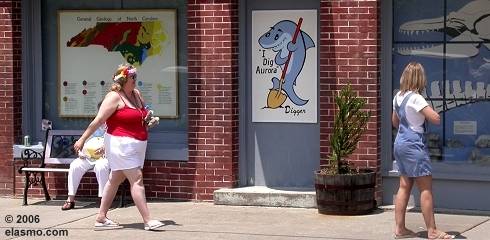
To show its appreciation of museum participants (Smithsonian, NC
Maritime Museum, Duke Marine Lab, etc) and volunteers, PCS Phosphate organized a special end-of-spring collecting event to a fresh area. This trip brought back memories of the old days at Aurora, with large teeth in relative abundance and associated finds of other fossils not uncommon. The area is toward the east and approaching the river (the other side of the reclamation). Exposed to weathering for only a year or so, these hills still need plenty of rain and larger specimens were relatively more abundant than smaller ones.
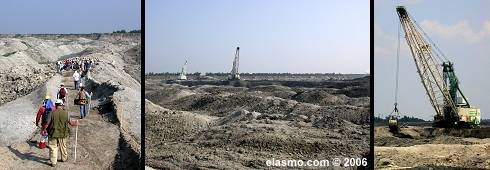
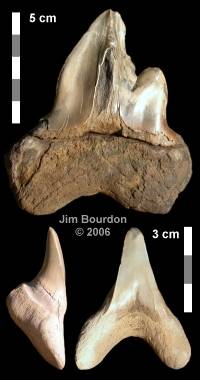 A 6-1/4 inch (Reggie Titmus), several 5-inch class (Don Ward, Kim Greene, Lee Cone & Mike Keklak) and many smaller megs were found, an indication of the area's potential. If size doesn't matter, consider Bonnie Chaussee's spectacular, albeit grotesque, 3-1/2" lower anterior (image). Other more readly exposed teeth included large hastalis (numerous) and two Parotodus (Richard Chandler & Nando Musmarra's 2-incher, see image). Todd and Heather Power recovered 25 associated shark vertebrae and most visitors returned with an abundance of marine mammal finds.
A 6-1/4 inch (Reggie Titmus), several 5-inch class (Don Ward, Kim Greene, Lee Cone & Mike Keklak) and many smaller megs were found, an indication of the area's potential. If size doesn't matter, consider Bonnie Chaussee's spectacular, albeit grotesque, 3-1/2" lower anterior (image). Other more readly exposed teeth included large hastalis (numerous) and two Parotodus (Richard Chandler & Nando Musmarra's 2-incher, see image). Todd and Heather Power recovered 25 associated shark vertebrae and most visitors returned with an abundance of marine mammal finds.
Lest we leave the reader with the impression that this area will be used for the fall season, please don't count on it. It currently lacks adequate access, may get flooded by water or inundated by reclamation. However, it has the potential of being a bountiful area if our collective prayers are answered.
|
| May 07, 2006 |
|
Weekend 10 - The Final Weekend
Pat Young reports: As the spring season drew to a close, dry dusty conditions, rampant vegetation growth and encroaching reclamation appeared to have taken their toll on NCPC Block collecting. However, this past Saturday proved that there were still good fossils available.
Friday's heavy rain helped a group of enthusiastic members of the North Coast Fossil Club (OH), Dahlgren Fossil Club (VA) and non-club collectors to uncover some outstanding specimens. Meg/chubbie teeth ranged in size from 5-1/8 inches to Paul Regel's 3/8-inch symphyseal; David Wright's chubutensis posterio-lateral was particularly pretty. Parotodus benedini teeth have been especially scarce this season; however, an anterior and lateral tooth were found Saturday (see image of Roger Sesterhenn's 2-1/2 incher). Broad-form hastalis topped out at 2-5/8 inches although the Pungo produced some narrow-forms nearly as large. Two very nice Squalodon molars were found (image of Steve Noel's 2-incher ) as were quite a few Notorynchus teeth and ray dermal scutes.
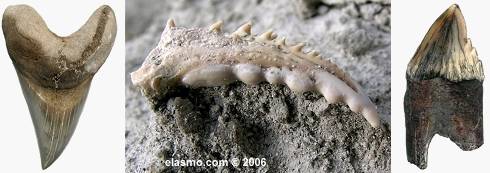
Sunday's group, including the New Jersey Paleontological Society, Delaware Mineralogical Society and National Aquarium (DC), suffered a bit from the previous day's success. Shark teeth were much smaller with most collectors appearing to have worked the Pungo. Jason Barrowclough managed to pick up a nice Echinocardium kelloggi test and BJ Blake an overlooked crab claw (sp.?) still sporting its spines (1-3/8", see image). Amazingly, a few whale vertebrae showed up in collector's buckets. Other finds were the usual assortment of Lee Creek offerings.
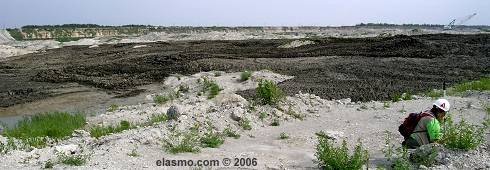
In a few weeks, this entire collecting area will be covered with tons of reclamation soils, soon to be turned back to its former condition. Watching its progress has been interesting and informative to those who have never seen the process before.
In closing, we'd like to thank PCS Phosphate-Aurora and especially Curtis Ormond of the Public Affairs Dept. for allowing us this collecting opportunity.
Editors note: A round of 'Thank Yous' must go out to the guides that are an integral part of the experience. When collecting is great, it's one of the best 'jobs' in the world, but when collecting drops off... And let's not forget an expression of appreciation to Pat for her detailed reporting of both the collecting results and the transition of the mine.
|
| April 29, 2006 |
|
Weekend 9 - With the help of rain
Pat Young reports: Members of the Eastern Missouri Society for Paleontology, Delaware Valley Paleontological Society, Calvert Marine Museum Fossil Club and several non-club affiliated visitors gathered in the parking lot for MSHA indoctrination. Candace used the South mine entrance, making for easier navigation to far areas of the pit. This past week's 1+ inch of rain was a boost for the day's collecting. Unfortunately, it also allowed the grasses a much needed growth enhancement, causing runners as long as 12 feet to begin a natural reclamation. Not to be outdone, collectors did some creeping of their own and most were well rewarded.
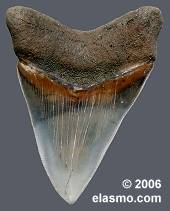 The largest C. megalodon found this season was represented by Eric Sadorf's 5-3/4 x 5-1/8 black reworked tooth. Although showing the typical dings, there was still plenty of enamel left, making for a great collector item. John Keklak (ref image) followed with a very nice 4-1/8 inch Yorktown tooth and Tim Fahrer's 2-3/4 inch C. chubutensis was absolutely perfect; several smaller megs were also found. On the opposite side of the collecting experience, Stan Wall spent the day on his knees and managed to add Rhincodon, Squatina, stingray and a small C. carcharias to his collection. Rain washed soils exposed some very nice Notorynchus and broad hastalis teeth. Pungo collectors were awarded with an abundance of small teeth, including one nice bramble. A complete Sciaenops ocellatus (Red drum) upper pharyngeal toothplate was found by John Everette and fish vertebrae in very good condition were collected by most others. Cetacean fossils were best represented by some outstanding periotics but no bullas or vertebrae were reported.
The largest C. megalodon found this season was represented by Eric Sadorf's 5-3/4 x 5-1/8 black reworked tooth. Although showing the typical dings, there was still plenty of enamel left, making for a great collector item. John Keklak (ref image) followed with a very nice 4-1/8 inch Yorktown tooth and Tim Fahrer's 2-3/4 inch C. chubutensis was absolutely perfect; several smaller megs were also found. On the opposite side of the collecting experience, Stan Wall spent the day on his knees and managed to add Rhincodon, Squatina, stingray and a small C. carcharias to his collection. Rain washed soils exposed some very nice Notorynchus and broad hastalis teeth. Pungo collectors were awarded with an abundance of small teeth, including one nice bramble. A complete Sciaenops ocellatus (Red drum) upper pharyngeal toothplate was found by John Everette and fish vertebrae in very good condition were collected by most others. Cetacean fossils were best represented by some outstanding periotics but no bullas or vertebrae were reported.
Although tooth finds are mostly getting smaller in size, it appears that the quantity is still there for those willing to do some scouting for unsearched areas.
|
| April 25, 2006 |
|
Underwood papers
 In this era of the Internet, it is remarkable how few papers are readily available (on a non-subscription basis). Birkbeck University is putting together a permanent listing of papers published in England, and most of Charlie Underwood's papers are available to the public through this site. You are encouraged to sample his research; most can be summarized as Mesozoic sharks of England. In this era of the Internet, it is remarkable how few papers are readily available (on a non-subscription basis). Birkbeck University is putting together a permanent listing of papers published in England, and most of Charlie Underwood's papers are available to the public through this site. You are encouraged to sample his research; most can be summarized as Mesozoic sharks of England.
|
| April 22-23, 2006 |
|
Weekend 8 - The final leg
Jim Bourdon reports: With three weeks left to the season, the god's challenged the will of this week's visitors -- $3.00+ gasoline, severe weather, late season tailings and the encroaching reclamation flow. Despite these obstacles, there was a remarkable turnout by members of the Midland's Fossil Club (SC), Suanee Creek Fossil Club (VA), University of Michigan Museum of Paleontology, Florida Fossil Hunters, Lee County Fossil Club (FL) and Gem & Mineral Society of the Virginia Peninsula. Saturday's collector's encountered cool (60s), cloudy and windy conditions that turned severe at 3:01; in contrast, Sunday's group had a warm (80s) and sunny day. Each was similarly challenged with typical late-season collecting conditions -- well picked tailings.

Despite the obstacles, visitors generally had a good time and a diverse group of fossils (albeit smaller than their early season counterparts) were collected by most. Complete megalodon teeth are now three-inches or smaller in length and hastalis usually under two. The well-worked Yorktown tailings have been stingier with cuvier, Hemipristis and Carcharhinus teeth, however Pungo sediments helped fill the void for many. Unusual earlier in the season, this weekend produced three bramble teeth (Howie Cohn, Heather Greer & Ken Young). There were still Pungo exposures yielding Carcharias, contortus, aduncus, Hemipristis and Carcharhinus teeth in abundance, with the occasional Sphyrna & Alopias. The late-season transition from walking the Yorktown to crawling the Pungo has officially commenced.
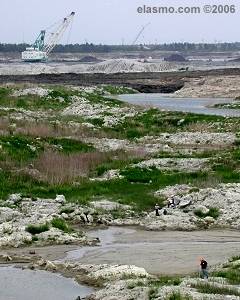 Surprisingly, whale vertebrae are still available and continue to be carried out; less so are their teeth and bulla, which appeared to have dropped off. Another seal incisor was found (Chuck Ferrara) and dolphin/porpoise teeth appear abundant in Pungo tailings. There was a nice variety of fish material (barracuda & bluefish dentaries, hake & drum premaxillaries, tuna hypural and an unusual braincase) but less common than in earlier weeks. Bird material was reported, but also in lesser quantities.
Surprisingly, whale vertebrae are still available and continue to be carried out; less so are their teeth and bulla, which appeared to have dropped off. Another seal incisor was found (Chuck Ferrara) and dolphin/porpoise teeth appear abundant in Pungo tailings. There was a nice variety of fish material (barracuda & bluefish dentaries, hake & drum premaxillaries, tuna hypural and an unusual braincase) but less common than in earlier weeks. Bird material was reported, but also in lesser quantities.
As can be seen in the encroaching reclamation flow, tailings available earlier in the season are now covered. It is uncertain as to the long-term consequences of this process. It could truncate the collecting area, or perhaps provide land bridges to islands not currently available to collectors.
|
| April 16, 2006 |
|
Weekend 7 - The eye of the beholder
From a collecting standpoint, Easter weekend is generally a lull in the spring season; this Saturday, the mine saw less than the normal number of visitors. Pat and I even contemplated skipping this week's overview when a first-timer dropped an e-mail -- we'll let him provide this week's report.
Gene Troskey reports: I really enjoyed collecting with George Powell on Saturday. He was trying to help me start a "diversified" collection and he succeeded. Here is a short, quick summary of the specimens I carried home:
whale vertebrae, many, also 7" cervical vertebrae (the best fossil of the day)
porpoise or dolphin vertebrae, many
porpoise ear bone
shark vertebrae, I think
fish vertebrae, maybe tuna
whale and porpoise rib bones, many
fish mouthparts, jaw, bones behind gills of puffer or parrot fish?
shark teeth, 20
whale tooth
ray teeth
snails: tulip, olive, slipper, etc.
bivalves: clams, scallops, casts
coral
phosphate nodules, shiny with many tunnels and holes
crab claws
sea urchin spines
sand dollar fragments
bryozoan colony on snail, on echinoderm
worm tubes, I threw those away (I can't collect everything)
walrus skull
partial cormorant skeleton
Just kidding about the walrus and cormorant...When you write your summary of Weekend 7 for Elasmo.com, hold a paragraph for … what a first-time, beginner paleontologist can find in one day, if he has an experienced, 30-year veteran for a guide.
Thanks, Pat, for a real fun day. Thanks to Candace Holliday. Thanks to every one else whose names I do not know.
|
| April 13, 2006 |
|
Aurora Fossil Festival
The 13th Annual Aurora Fossil Festival will kick off with opening ceremonies on Friday, May 26 at 6pm on the main stage beside the Aurora Fossil Museum parking lot. Mike Gwynn of PCS Public Affairs Dept. and a longtime ally of fossil collectors at PCS will be Fossil Master.
Saturday, festivities start at 9am with the Fossil Parade running at 11am. The museum auction will start at 3pm at the AFM Education Building with fossils and related items on preview all day. PCS Phosphate will again be giving free tours of the mine from 11am until 4pm. Several paleo vendors will be showing top quality fossils from a variety of sources. For those who choose to dig their own fossils, PCS will be providing fresh mine tailings at several places around town.
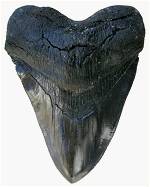 This years' raffle tooth, donated by the Friends of the Museum, measures in at 6 inches vertical height. Recovered from a South Carolina riverbed, it has had a minor bit of tip repair but still remains an outstanding example of Carcharocles megalodon. The color is rich and serrations are sharp.
This years' raffle tooth, donated by the Friends of the Museum, measures in at 6 inches vertical height. Recovered from a South Carolina riverbed, it has had a minor bit of tip repair but still remains an outstanding example of Carcharocles megalodon. The color is rich and serrations are sharp.
Representatives from the Smithsonian Institution, NC Museum of Natural Science, Duke University, Calvert Marine Museum and several fossil clubs will be displaying and helping the public with identification of specimens.
Great food and music and a street dance at the waterfront round out the evening fun. For more information, please call the Aurora Fossil Museum at 252-322-4238.
|
| April 11, 2006 |
|
Website updates
Last month I had the opportunity to visit the Gordon Hubbell and Mark Harris collections and was able to scan a number of additional specimens for the Dentition slide-show. They included corrections of two species (Carcharhinus borneensis & cautus) and a dozen or more additional shark and ray jaws. Some of these specimens are very scarce and one which might be of particular interest is a broad-form Alopias superciliosus.
 Mark alerted me to a new Collins publication A Field Guide to the Sharks of the World with Compagno as senior author. It is comprehensive, very well illustrated, includes a new checklist and many additional species. With this new information, the Shark Species slide-show has been updated (re-written actually) and will hopefully prove more useful. If you don't want to hold your breath for the remaining FAO volumes, this is an excellent substitute.
Mark alerted me to a new Collins publication A Field Guide to the Sharks of the World with Compagno as senior author. It is comprehensive, very well illustrated, includes a new checklist and many additional species. With this new information, the Shark Species slide-show has been updated (re-written actually) and will hopefully prove more useful. If you don't want to hold your breath for the remaining FAO volumes, this is an excellent substitute.
|
| April 8, 2006 |
|
Weekend 6 - In the path of reclamation
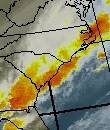 Pat Young reports: Although Saturday morning dawned gray and windy, with a forecast of severe weather, forty-two energetic collectors gathered in the PCS parking lot. The storm held off until 3 PM after which the weather predictions came true. Heavy rain, lightening and thunder, with winds nearing 40 mph and some hail, ruled the rest of the afternoon and late into the night. Tornados spared us but we lost electricity for a brief time. The deposited inch and a half of rain should help next week's collectors.
Pat Young reports: Although Saturday morning dawned gray and windy, with a forecast of severe weather, forty-two energetic collectors gathered in the PCS parking lot. The storm held off until 3 PM after which the weather predictions came true. Heavy rain, lightening and thunder, with winds nearing 40 mph and some hail, ruled the rest of the afternoon and late into the night. Tornados spared us but we lost electricity for a brief time. The deposited inch and a half of rain should help next week's collectors.
Members of the Catawba Valley Gem & Mineral Society, Black River Fossil Club (SC), Columbus (Ohio) Rock & Mineral Society and the North Carolina Aquarium (Fort Fisher) met with several non-club groups to sample the fossil offerings. The north mine-pit ramp, which had not been used since the first of the spring season, was chosen for entrance. Several weeks of heavy winds and a slight amount of rain the previous week held high hopes for the area. Still most collectors headed toward the back of the mine.
Several nice chubutensis were found with Heard Smith showing the largest two (3-1/4 & 3 inches); smaller ones were found by Wayne Bowman, Barbara Bowman, Ramona Krailler, Paul Busone and Phil Busone. Quite a few nice Cosmopolitodus (broad and narrow forms) surfaced with anteriors up to 2-1/4 inches (Lee Collins, John Steffensen). Notorychus lowers seemed to be in most collections but Tom Savisky's upper was especially nice. George Oliver and Ken Young each had split-tip P. contortus but other shark finds were the usual smaller teeth. Newcomers Jim Snyders and Hilda Brown brought out nice large whale vertebra. Large sperm whale teeth were found by Brad Jenkins and Grady Smith (2) with smaller ones shown by others. Jerry Sellers reported a "fistful of makos" and showed a 5-inch posterior section of Squalodon jaw with two tooth sockets. Eric Sadorf found a wee (5mm) sand dollar while Clay Johnson got a nearly nine-inch marlin upper rostrum. With a larger than usual number of first time collectors today, fish and other fossils were heavily collected.

A necessary component of the mining industry involves the restoration of mined areas. This past weekend revealed a moderately large part of our collecting area in the northern part of the pit is being reclaimed. An unfortunate victim of this progress was the area under excavation by the Aurora Fossil Museum for additions to its associated C. megalodon tooth-set. These nice Yorktown sediments are now under up to 40 feet of dark, soft soils which will eventually allow this area to be put back to its original state of hardwood forest and wetlands. The reclaimed areas are extremely hazardous and are strictly out of bounds to collectors, whether or not they have a posted flag line.
|
| April 1-2, 2006 |
|
Weekend 5 - Where be the rain?
Pat Young reports: As members of the Cape Fear Gem & Mineral Society, East Coast Fossil, North Carolina Shell, Coccinellidae Fossil Club, Tampa Bay and Southwest Florida Fossil Clubs along with several non-club persons met for collecting, Mother Nature played a nice April Fool on us --the forecast rain passed us by; leaving a very pleasant day in the sun. Unfortunately there had been no rain the week before, making for very dusty conditions. Spring has definitely sprung at Lee Creek and the ground cover of clover and sprouting grasses is making the hunt for fossils much more difficult even though this season's new roads do make walking to far areas quite comfortable.
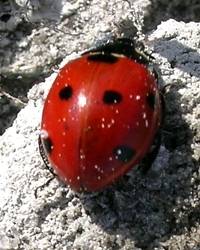 The search for megs continues although early season confidence is waning. Rather than spend time crawling the overgrowth, Jean Brown proceeded to dig her way to a 3-1/4 inch C. megalodon. Andy Albright collected a 3 inch one and Linda Wooten came up with a re-worked 3-3/4 inch tooth; several smaller ones were also found. The most unusual tooth find of the day was Dominic Sinibaldi's 2-1/4 inch Parotodus. Intent on finding inverts, Septem Punctata (image) was seen employing the Pungo crawl most of the day. Collecting bags had plenty of smaller, more ordinary shark teeth. In addition to the hundreds of small bony fish fossils collected, Steve Wilson found a marlin dorsal spine, Jeff Preston a great marlin vertebra and David Wooten a nice tuna upper jaw with 10 teeth.
The search for megs continues although early season confidence is waning. Rather than spend time crawling the overgrowth, Jean Brown proceeded to dig her way to a 3-1/4 inch C. megalodon. Andy Albright collected a 3 inch one and Linda Wooten came up with a re-worked 3-3/4 inch tooth; several smaller ones were also found. The most unusual tooth find of the day was Dominic Sinibaldi's 2-1/4 inch Parotodus. Intent on finding inverts, Septem Punctata (image) was seen employing the Pungo crawl most of the day. Collecting bags had plenty of smaller, more ordinary shark teeth. In addition to the hundreds of small bony fish fossils collected, Steve Wilson found a marlin dorsal spine, Jeff Preston a great marlin vertebra and David Wooten a nice tuna upper jaw with 10 teeth.
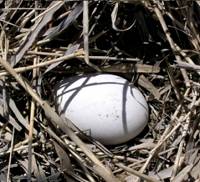 Sunday's group consisted of the National Capitol Fossil Society, Richmond (VA.) Gem and Mineral Society, Charlotte (NC) Gem & Mineral Club, Gem, Mineral & Lapidary Society of Montgomery County, MD and some unaffiliated collectors. Although megs are the most coveted Aurora tooth, today's offerings were few. One 3+ inch specimen in matrix was found but all others were much smaller. Cosmopolitodus seemed more abundant and larger than Saturday's crowd had shown but most other teeth were the usual suspects. Becky Hyne did manage to pick up a pretty, blond Echinorhinus blakei tooth. Whale & porpoise vertebra & teeth, shells & other inverts and fish fossils were heavily collected by the first-time Aurora visitors. Sunday's group consisted of the National Capitol Fossil Society, Richmond (VA.) Gem and Mineral Society, Charlotte (NC) Gem & Mineral Club, Gem, Mineral & Lapidary Society of Montgomery County, MD and some unaffiliated collectors. Although megs are the most coveted Aurora tooth, today's offerings were few. One 3+ inch specimen in matrix was found but all others were much smaller. Cosmopolitodus seemed more abundant and larger than Saturday's crowd had shown but most other teeth were the usual suspects. Becky Hyne did manage to pick up a pretty, blond Echinorhinus blakei tooth. Whale & porpoise vertebra & teeth, shells & other inverts and fish fossils were heavily collected by the first-time Aurora visitors.
With the middle of the season approaching, more collectors are bringing rakes and other digging tools. Please put your name on your tool to insure it gets back to you at day's end. And lastly, contrary to the author's own assertions, the mother goose only hissed when her nest was approached for the accompanying photo -- do what I say, not what I do.
|
| March 25-26, 2006 |
|
Weekend 4 - Two voices
Pat Young reports: Another cold, windy morning greeted those gathering in the PCS parking lot on Saturday. Members of the Aurora Fossil Club, American Fossil Federation, Educators of Excellence Fossil Club and Friends of Museum seemed not to mind, they would be the first of the season to collect rain-washed tailings. Walking sticks were put to good use in getting down the slippery south ramp but navigation in the pit was quite comfortable. Glistening dew made the search for fossils much easier and just minutes into the mine, Steve Noel found a large stingray dermal scute while wife Marge picked up a Notorynchus lower.
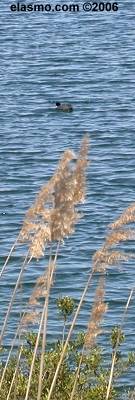 New collector Sue Dew got the largest Carcharocles megalodon, a perfect 4-1/4 inch upper; several others were found in the 3+ inch range. Cosmopolitodus teeth were best represented by Matt Howard's beautiful lower anterior broad-form (2+ inches) and Mike Murrow's 2-inch upper. A good sampling of G. cuvier, Hemipristis and Notorynchus teeth were collected while hundreds of Carcharhinus teeth were left lying for Sunday's group to pick. Interest in inverts remains high but today produced only one sand dollar (Mellita sp), one Arbacia sp and a nice Echinocardium kelloggi. Carcharodon carcharias teeth seem to be scarce in this area but one rootless specimen was recovered. With the bulk of today's group being teachers, the usual assortment of cetacean vertebrate & teeth, shells (one person was actually looking for clams!) and steinkerns were heavily collected.
New collector Sue Dew got the largest Carcharocles megalodon, a perfect 4-1/4 inch upper; several others were found in the 3+ inch range. Cosmopolitodus teeth were best represented by Matt Howard's beautiful lower anterior broad-form (2+ inches) and Mike Murrow's 2-inch upper. A good sampling of G. cuvier, Hemipristis and Notorynchus teeth were collected while hundreds of Carcharhinus teeth were left lying for Sunday's group to pick. Interest in inverts remains high but today produced only one sand dollar (Mellita sp), one Arbacia sp and a nice Echinocardium kelloggi. Carcharodon carcharias teeth seem to be scarce in this area but one rootless specimen was recovered. With the bulk of today's group being teachers, the usual assortment of cetacean vertebrate & teeth, shells (one person was actually looking for clams!) and steinkerns were heavily collected.
This season, the ducks and coots have taken a liking to our collecting area and several nests have been seen. These ducks can be diligent in protecting their territory so it is best to avoid disturbing them. For those uninitiated, it can be quite startling to have a large, squawking bird fly at your face. After the hunt, everyone was invited to the Aurora Fossil Club BBQ dinner in Aurora. Those not attending missed a great meal and social hour.
BJ Blake reports: Sunday morning started as had Saturday - low 30s with 10-20 mph NW winds, causing all to bundle up for collecting (well - almost all, there were a few brave souls more accustomed to chilly weather). To expand on Jim's suggestion of last weekend, it is always a good idea to bring more layers of clothing than you think you might need, as they can be peeled off as the day warms. I think many today would have been very thankful for a hood or scarf for the ears and gloves for chilly fingers. (I find weight lifting or driving gloves to work great as the fingertips are exposed.)
The partly cloudy skies and a high temperature of about 53-degrees did not stop the fossil hunters from the Maritime Museum (Beaufort, NC), Southwest High School (Jacksonville, NC; teachers all), Vulcan Materials Dolcito Quarry & Museum (Birmingham, AL) and others. Shark tooth finds included a number of C. chubutensis (up to 3-1/2"), C. megalodon (to 3-1/2"), a 2-1/2 inch broad-form hastalis and the usual suspects (Hemipristis, Notorhyncus, Cosmopolitodus, Carcharhinus, etc). Other finds included a seal astragalus, Squalodon incisor, cetacean radii & phalanges, bird bones, porpoise teeth and a sperm whale tooth. A number of vertebrae were recovered as were a few Echphora. Associated marine mammal material is difficult to find, but a set of four whale vertebrae and three teeth was located by one collector with great diligence. Also of note were Ellie Rouse's echinoid finds: an Echincardium kelloggi, Arbacia improcera and please note, the second known Encope (arrow-shaped sand dollar) from this area.

As noted last week, weeds & grasses tend to cover much of the tailings and the ground creepers are waiting to trip those willing to brave the overgrown areas. As we went into the same area as last week, the guides have become better acquainted with the weeds and the fossils hidden therein. This growing knowledge should better serve novice collectors in future weeks. Fortunately, we received about 3-inches of rain last week and expect more later this week; this should help expose more of what visitors are all after, at least until it spurs new weed growth.
|
| March 18-19, 2006 |
|
Weekend 3 - Exodus 2.3
Jim Bourdon reports: Having had the opportunity of collecting this weekend, it seemed appropriate to provide another perspective using Pat's results-based data.
As experienced the first weekend, the weather was again cool. Early morning frost and NW winds can make collecting uncomfortable if not properly prepared. During these early season visits, a windbreaker of some sort is recommended, as are gloves. I carry a knit cap for these circumstances and although useful the first weekend, was not necessary this time. Properly attired or not, Saturday's group was made up of Friends of the Museum members while Sunday's collectors were from the North Carolina Fossil Club (Raleigh).

Rather than assaulting the tailings from the western rim (as in previous weeks and last season), Candace parked the bus (as would Becky on Sunday) on the southern edge. Doing so brought these well-weathered sediments into the collecting-range of all. (From personal experience, these tailings were more productive than 'new' areas to the north east.)
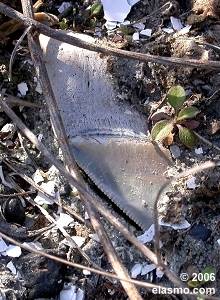 Problematic with these aged exposures are the weeds (tall, bamboo-like) that claim these tailings as their own. Protected by this vegetation, nice specimens (4-1/8" meg, ref image) can be readily overlooked. Don't expect large teeth to be fully exposed or small teeth to be presented on pedestals, the Yorktown tailings have been well worked as is the case with many of the Pungo areas. A four-inch class meg tooth was found each day with Rick Phillips' black Pungo specimen the largest (4-1/4"); numerous smaller examples were also collected. Cosmopolitodus teeth appear to still be available, but few are more than an inch-or-so in length. Most shark tooth finds were the usual suspects with distinctions going to Becky Hyne's Parotodus benedeni and Anne Lineberry's Hemipristis serra (both 2-inch laterals). Several nice batoid scutes were also found.
Problematic with these aged exposures are the weeds (tall, bamboo-like) that claim these tailings as their own. Protected by this vegetation, nice specimens (4-1/8" meg, ref image) can be readily overlooked. Don't expect large teeth to be fully exposed or small teeth to be presented on pedestals, the Yorktown tailings have been well worked as is the case with many of the Pungo areas. A four-inch class meg tooth was found each day with Rick Phillips' black Pungo specimen the largest (4-1/4"); numerous smaller examples were also collected. Cosmopolitodus teeth appear to still be available, but few are more than an inch-or-so in length. Most shark tooth finds were the usual suspects with distinctions going to Becky Hyne's Parotodus benedeni and Anne Lineberry's Hemipristis serra (both 2-inch laterals). Several nice batoid scutes were also found.
Marine mammal material is still available. Of particular note were: a partial seal jaw with three teeth (Becky Hyne), an associated whale bulla & periotic (Todd Power) and a complete cetacean atlas vertebra (Kitty Wells). Various other body parts and teeth (including Squalodon) were represented in the finds of many visitors. Bird material is still being carried out, but it is less common and the condition, poorer. Invertebrate material continues to attract interest, most notably the echinoids: Echinocardium kelloggi (Nando Musmarra & Bobby Tant), Arbacia improcera (Dave Sanderson & Joy Herrington) and Psammechinus philanthropus (Xan Dubrok).
Pat noted that for some reason, Sunday collectors have out performed those on Saturday -- certainly a counterintuitive observation. Rain is finally being called for on Monday/Tuesday, which should help next weekend's visitors.
|
| March 11-12, 2006 |
|
Weekend 2 - Still producing
Pat Young reports: After last weekend's freezing temperatures and strong NW winds, this weekend's weather seemed a heat wave, producing temps in the low 80's. Both day's groups consisted of Friends of the Museum members.

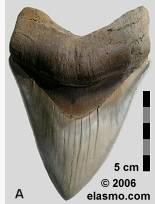 On Saturday, Bea Hall set an early morning precedent by picking a crocodile tooth (Thecachampsa antiqua) from the mine parking lot. This much larger collecting area makes it harder to meet people in the field, so I don't know if she topped that find. In the pit, most collectors quickly headed toward the back in search of previously overlooked Yorktown exposures. Uwe Heine managed to bring in the largest C. megalodon - a stunning 4-3/4 inch upper anterior (figure A). Richard Aultman, Lee Cone and several others found smaller ones, including chubutensis. Eric Sadorf got the only Parotodus benedeni - a 1-3/4 inch Pungo tooth. The usual assortment of other shark teeth was seen; upper and lower Cosmopolitodus hastalis and Notorynchus were found by most. Very large tiger shark teeth (G. cuvier) continue to be amazingly abundant. Whale vertebrae and other fossil bones were seen leaving the mine by the bucketsful - most destined for classroom use.
On Saturday, Bea Hall set an early morning precedent by picking a crocodile tooth (Thecachampsa antiqua) from the mine parking lot. This much larger collecting area makes it harder to meet people in the field, so I don't know if she topped that find. In the pit, most collectors quickly headed toward the back in search of previously overlooked Yorktown exposures. Uwe Heine managed to bring in the largest C. megalodon - a stunning 4-3/4 inch upper anterior (figure A). Richard Aultman, Lee Cone and several others found smaller ones, including chubutensis. Eric Sadorf got the only Parotodus benedeni - a 1-3/4 inch Pungo tooth. The usual assortment of other shark teeth was seen; upper and lower Cosmopolitodus hastalis and Notorynchus were found by most. Very large tiger shark teeth (G. cuvier) continue to be amazingly abundant. Whale vertebrae and other fossil bones were seen leaving the mine by the bucketsful - most destined for classroom use.

Sunday's group seemed more tooth oriented and although the tooth size was generally smaller than the previous day's, some very nice finds were made. Scott Kusluch brought in the largest megalodon, a nice 4-inch Yorktown specimen. Others, both meg and chubs, were found by Grady Frame (huge 3-1/4" Pungo posterio-lateral, see figure C), Bob Henderson (3"), Kip Lawrence (2-7/8"), Keith Robertson (3"), Tim Isenhower (2-1/4" black Pungo), Dolly Clifton (2-1/2") and a nice blue-gray posterior by Fred Plumb. Sharron Edwards matched George Klein's find of last week with a 2-1/4 inch upper anterior symphyseal-type Yorktown meg. Several large hastalis, both broad and narrow-forms, were seen, including those found by Grady Frame (2-5/8" lower), Barb Van Hemel (2" lower), Fred Plumb (2" upper) and Paul Murdoch (1-7/8" lower). A closer-to-the-ground approach is producing more sand tiger teeth, but no Echinorhinus or Hexanchus teeth have been reported yet this season. Although sperm whale teeth had seemed scarce, today they made a good showing with those by Grady Frame, Wes Schaible, Mac Lane and Robert & Tara Gates (in the 4-5+ inch range); several smaller ones were also found. Pete Karapanagiotides started on a search for shark teeth and got sidetracked by a boulder containing a nice cetacean vertebra.

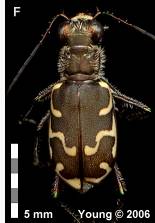 Combing both day's collecting efforts revealed some neat other finds: complete 12-inch marlin (Makaira sp) rostrum (Bill Killen, figure E), Pungo sand dollar (Rik Poropat), ray/skate dermal denticles (Ben Peters, Amanda Cone, BJ Blake, Ron Edwards) and an outstanding barracuda dentary (figure D) by Richard Zeeman. Unusual marine mammal fossils included a seal sternum, patella and calcaneum by Ron Edwards, seal humerus (Keith Robertson) and Squalodon molar (Paul Van Hemel). Roberta Dann found a small limpet (Diodora pamlicoensis), Keith Robertson three pieces of fossil resin (figure B) and Harry Zirlin was seen collecting Bronze Tiger beetles (Cicendela repanda, figure F). He assured us the main diet of these beetles and their larvae is ants. Given the abundance of fire ants in the mine, we certainly welcome these insects.
Combing both day's collecting efforts revealed some neat other finds: complete 12-inch marlin (Makaira sp) rostrum (Bill Killen, figure E), Pungo sand dollar (Rik Poropat), ray/skate dermal denticles (Ben Peters, Amanda Cone, BJ Blake, Ron Edwards) and an outstanding barracuda dentary (figure D) by Richard Zeeman. Unusual marine mammal fossils included a seal sternum, patella and calcaneum by Ron Edwards, seal humerus (Keith Robertson) and Squalodon molar (Paul Van Hemel). Roberta Dann found a small limpet (Diodora pamlicoensis), Keith Robertson three pieces of fossil resin (figure B) and Harry Zirlin was seen collecting Bronze Tiger beetles (Cicendela repanda, figure F). He assured us the main diet of these beetles and their larvae is ants. Given the abundance of fire ants in the mine, we certainly welcome these insects.
Summer heat and a much larger collecting area are making it much more important to carry extra water in the mine with you. The fresher areas are farther from the bus and 5-plus miles of walking over rough hills should not be an unreasonable expectation.
|
| March 4-5, 2006 |
|
Weekend 1 - Boogety, boogety, boogety
Pat Young reports: The much-awaited first day of the PCS Spring Season usually brings shivers of excitement. Saturday morning's shivers were more likely the result of 30-degree temperatures and strong NW winds. Although we had hoped for a new collecting area, news that the previous season's area had been combined with another previously used, brought great anticipation. This doubled our collecting area, providing much greater opportunities. Winter had turned last season's lush landscape into what initially appeared a barren wasteland, however fifty Friends of the Museum members wasted no time in getting their bearings and heading to far corners.
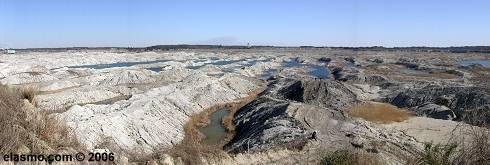
First weekend collectors are a lively group and getting an accurate count is difficult. Generally in search of C. megalodon / chubutensis teeth, most did manage to get at least one and some several. Although the size was generally small, megs are always a welcome sight. Jason Kowinsky came away with the largest complete tooth, a beautiful 3-1/2 incher. Dave Griffith brought out a great 3-inch lateral and two others. Al Klatt and Sharron Edwards had nice posterior chubbies. Mike Dunn had a pretty 3-inch chubbie (figure E) plus two more. Others were shown by Ron Harding (2), Pam Gentry, Melvie Hatfield (2), and Jay Goldberg. Paul Sangeorzan found a huge Pungo tooth, unfortunately in two pieces and George Klein an interesting 'symphyseal'-type specimen (figure D).
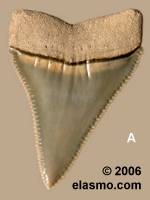 Four coveted Carcharodon carcharias teeth returned on the bus: Valerie Everette's 1-3/4" upper Yorktown specimen was the prettiest (figure A); black ones were shown by Gregg Walden and Paul Murdoch. Both broad and narrow-form Cosmopolitodus hastalis were well represented -- too many to document. The condition of most was excellent and the largest was a 2-7/8" lower first anterior (narrow-form). Lateral Hemipristis teeth in the 1-3/4" range were found by Trish Kohler, Reggie Titmus and Al Klatt. Notorynchus lowers seemed plentiful and cuvier continued last season's run of abundance -- one collector found 30! Although Carcharhinus teeth are not usually considered premium items, John Timmerman managed to come away with the most interesting tooth of the day - a highly contorted split-tip upper (figure F); Keith Robertson found a patho cuvier. Four coveted Carcharodon carcharias teeth returned on the bus: Valerie Everette's 1-3/4" upper Yorktown specimen was the prettiest (figure A); black ones were shown by Gregg Walden and Paul Murdoch. Both broad and narrow-form Cosmopolitodus hastalis were well represented -- too many to document. The condition of most was excellent and the largest was a 2-7/8" lower first anterior (narrow-form). Lateral Hemipristis teeth in the 1-3/4" range were found by Trish Kohler, Reggie Titmus and Al Klatt. Notorynchus lowers seemed plentiful and cuvier continued last season's run of abundance -- one collector found 30! Although Carcharhinus teeth are not usually considered premium items, John Timmerman managed to come away with the most interesting tooth of the day - a highly contorted split-tip upper (figure F); Keith Robertson found a patho cuvier.

Few collectors bothered with the nose to the ground technique, however Mike McCloskey did pick a Squatina tooth. Marine mammal fossils included Chuck Ball's (originally reported as Mike Folmer's) outstanding seal molar (figure B), Pam Gentry's 3-3/4" sperm whale tooth, Gary Thorne's arthritic porpoise humerus and finds by Mike McCloskey (cetaean bulla & humerus), Bob Belcher (pilot whale tooth), Fred Mazza (seal canine) and BJ Blake (partial walrus humerus). Quite a few small sperm whale teeth were also found. Other fossils of note were: Bluefish jaw (Jeff Sparks, see figure G), bird wing (George Klein), bird coracoid (Tom Caggiano), bird neck vertebra (Mike McCloskey), Cetorhinus gill raker (Keith Robertson) and a complete Arbacia improcera test (Reggie Titmus, see figure C); two sanddollars were also reported.

It appeared that Saturday's collecting had little effect on the Sunday people because more and larger teeth were found. The largest measured Carcharocles were Jo Ann Caffery's 3-3/4" upper, Debbie Burdette's 3-1/4" Pungo lower and newcomer Jason Osborne's 3-1/4" black upper. Mike Reece brought out a large golden chubutensis in limestone matrix. The smallest was Mel Gulotta's 1/2" x 1/2" black posterior; he also got 2-3/4" and 2-1/4" chubbies. Other very nice Carcharocles were found by Bill Heim (2-3/4") and Mike Keklak (2-3/4" YT lower) -- many smaller ones were also collected.
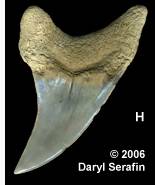 A quick peek into collecting bags revealed much larger broad-form hastalis than the previous day. In the excitement over a 2-7/8" upper A2 broad-form beauty, I neglected to note the name of the finder (later found to be Richard Habron). Mike Keklak and Debbie Burdette each got 2-1/4" uppers, Gregg Walden the largest lower (2-1/2") and George Powell a pathological upper lateral; too many others were seen to document. The prettiest Notorynchus was Gail Leget's pale yellow upper lateral. The only Isurus retroflexus was found by John Adams and Gregg Walden the only C. carcharias (1-1/2"). Other finds included Pam Platt's echinoid (Psammechinus philanthropus), John Keklak's seal canine, and sandollars by Debbie Burdette and Jason Osborne. Belatedly added to the News was Daryl Serafin's pretty Parotodus (image H) tooth.
A quick peek into collecting bags revealed much larger broad-form hastalis than the previous day. In the excitement over a 2-7/8" upper A2 broad-form beauty, I neglected to note the name of the finder (later found to be Richard Habron). Mike Keklak and Debbie Burdette each got 2-1/4" uppers, Gregg Walden the largest lower (2-1/2") and George Powell a pathological upper lateral; too many others were seen to document. The prettiest Notorynchus was Gail Leget's pale yellow upper lateral. The only Isurus retroflexus was found by John Adams and Gregg Walden the only C. carcharias (1-1/2"). Other finds included Pam Platt's echinoid (Psammechinus philanthropus), John Keklak's seal canine, and sandollars by Debbie Burdette and Jason Osborne. Belatedly added to the News was Daryl Serafin's pretty Parotodus (image H) tooth.
It was a very good first weekend. Hopefully, when rains wash the new tailings left by bulldozer tracks, the area will continue to produce well.
|
| February 27, 2006 |
|
Cappetta & Nolf 2005
In 2005, Cappetta & Nolf released their long anticipated Revision de quelques Odontaspidae (Neoselachii: Lamniformes) du Paleocene et de l'Eocene du Bassin de la mer du Nord. For those interested in Paleogene sediments along the Western North Atlantic, this paper is very important -- most sand tiger tooth identifications are tightly linked to the European fauna and those that write about. Their conclusions have great impact on the identifications ascribed to various U.S. teeth, so it was necessary to properly consider their observations. I started visiting this topic in early fall, and enlisted Steve Cunningham's help in October. By late fall, a European perspective was required, and Pieter De Schutter joined the project. The net result was that many changes needed to be recognized by elasmo.com and those that collect these sediments (see: review).
The largest impact was to that comfortable bucket "Carcharias hopei" -- it's gone. Most of these teeth are now attributed to Hypotodus verticalis.
Carcharias robustus teeth are now assigned to
Jaekelotodus and
"C. teretidens" to Sylvestrilamia. Those lerichei teeth that have bounced around, depending on author, have been assigned to the newly erected genus,
Brachycarcharias.
We found it necessary to question some of their determinations and find fault with aspects of their presentation. However, the overall conclusions are sound, and elasmo.com will follow them. This largely affects the Paleogene fauna pages for the Aquia and Nanjemoy Formations.
|
| February 24, 2006 |
|
Chandler's Hemipristis Paper
The most recent issue of Palaeontologia Electronica (vol 9:1) includes the paper Quantifying a Possible Miocene Phyletic Change in Hemipristis (Chondrichthyes) Teeth by Richard E. Chandler, Karen E. Chiswell, and Gary D. Faulkner. It is available on line palaeo-electronica.org/toc9_1.htm or as a .pdf file (700 kb) palaeo-electronica.org/2006_1/teeth/teeth.pdf.
|
| February 21, 2006 |
|
The Great White Paper Record
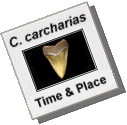 Over two years ago, Lutz Andres started a new paper for the Great White Evolution slide-show. Intended to trace the earliest reports of the Great white through the published record, it became a major project in itself. It is now being released as its own slide-show: C. carcharias - Time & Place. It is largely a reviewed bibliography augmented with author comments and some great specimens from many of the discussed locations.
Over two years ago, Lutz Andres started a new paper for the Great White Evolution slide-show. Intended to trace the earliest reports of the Great white through the published record, it became a major project in itself. It is now being released as its own slide-show: C. carcharias - Time & Place. It is largely a reviewed bibliography augmented with author comments and some great specimens from many of the discussed locations.
|
| February 7, 2006 |
|
First Weekend
The collecting season will begin March 4th with initial slots going to AFM Friends. More details when available.
|
| January 18, 2006 |
|
Spring Season Announced
Well, Curtis has confirmed there will be Spring Season at PCS. Although the actual dates have not been established, the collecting area will be enlarged and he will be accepting snail and email requests through the end of January. It was amazing last season how many people arrived without steel-toed boots or just late. Please remember: be in the parking lot by 7:30 am, steel-toed footwear and hard hats are required and no shorts or sleeveless tops.
|
| January 12, 2006 |
|
Extant Dentitions
Over the holiday season, I had the opportunity to visit, review and image additional specimens from the Hubbell collection. Eight more extant dentitions have been added to the Extant Dentition slide-show -- nearly 150 are now included. Be sure to check out the Viper dogfish (Trigonognathus kabeyai) and Bigeye sand tiger (Odontaspis noronhai). In addition to adding new specimens, the slide-show has been re-designed. The 'species' page is presented systematically and the drop-down list alphabetically by genus/species. Additional comments on a particular dentition will now available from the 'Shark species' page.
|
| December 13, 2005 |
|
Isurus retroflexus
This past summer, Pat and I began a project to reconstruct an Isurus retroflexus tooth-set using Pungo River material. The project extended into the fall as we concluded there were two forms that needed to be addressed. With that said, we think the paper and accompanying reconstructions will be of interest. These pages have been added to the "Isurus Dentition" slide-show.
|
| December 10, 2005 |
|
Fossil Tooth-sets
Buried in elasmo.com are several fossil tooth-set reconstructions. Since it is expected that additional ones will be added in the next month-or-so, it seemed useful that there be a common interface to access them directly. Therefore, a new slide-show has been created for that purpose -- it is hoped you find it useful.
|
|
|